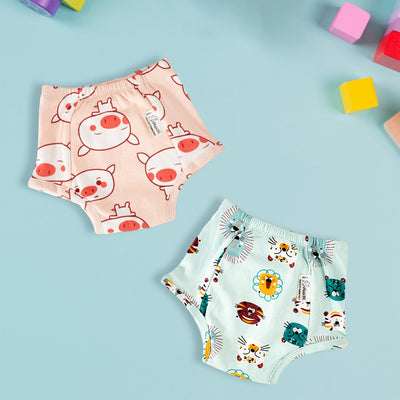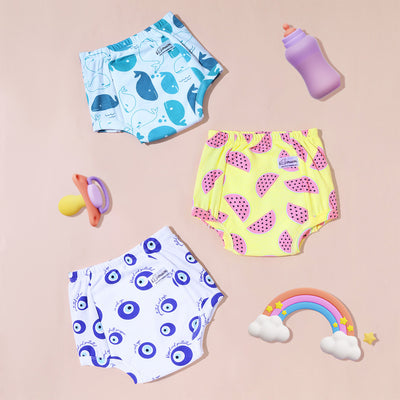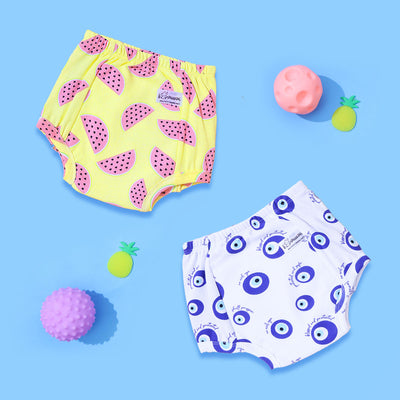Bedwetting in 4 - 6 Year Olds: What Parents Can Do
If your child is between 4 and 6 years old and still wetting the bed, you’re not alone, and you’re not doing anything wrong. You might think your child is the only one still wetting the bed, but it’s super common and not fully understood by many. While daytime potty training might be long done, nighttime dryness is a different skill that can take more time to develop.
In this blog, we’ll break down why bedwetting happens, what you can do to support your child, and how tools like padded underwear and potty training pants can make a big difference during this phase.
Is Bedwetting at Ages 4 to 6 Normal?
Yes, it is. Bedwetting can persist occasionally in many children up to the age of 7, and it’s usually nothing to worry about. According to pediatric experts, approximately 1 in 7 children still experience nighttime dryness by the age of 5. It’s important to understand that this isn’t a behaviour issue; it’s simply a part of their physical development that varies from child to child.
Some children take longer for their bladder and brain to communicate during deep sleep. Others may sleep so soundly that they don’t wake up when they need to go. If bedwetting was part of your or your partner’s childhood, your child may be more likely to experience it too, due to genetic factors
Common Causes of Bedwetting in Older Toddlers
1. Delayed Bladder Maturity
In some kids, bladder development takes a bit more time, making it harder to stay dry overnight. Their body might not yet produce enough of the hormone (ADH) that slows urine production while they sleep. This makes overnight dryness harder to achieve, no matter how well they’re potty trained during the day. It's not a matter of willpower; it’s biology.
2. Deep Sleepers
Kids who are very deep sleepers may not wake up to the sensation of a full bladder. Even if their brain receives the signal, they might sleep right through it. Deep sleep can make nighttime accidents more frequent, but it's not something they can control. These children often need more time to develop nighttime awareness.
3. Stress or Emotional Changes
Changes at home or school, like a new sibling, moving, or starting kindergarten, can affect a child's routine and emotional state. These emotional shifts may trigger temporary regressions, including bedwetting. Stress impacts sleep and behavior, and even subtle anxiety can make it harder for kids to stay dry at night.
4. Constipation
It’s surprising to many parents, but constipation is a common factor contributing to bedwetting. A full bowel can press on the bladder and reduce its capacity. Even mild constipation can throw off normal elimination patterns, leading to nighttime accidents. Regular bowel habits are key to successful potty training and nighttime dryness.
What Parents Can Do to Help
1. Stay Calm and Supportive
Your response matters more than you think. Getting upset or showing frustration may increase your child’s stress, which in turn can worsen the problem. Remember that bedwetting is not your child’s fault. Stay patient, avoid punishments, and offer encouragement instead. Celebrate dry nights and reassure them that progress takes time.
2. Use the Right Clothing - Like Padded Underwear
Using padded underwear at night gives your child comfort, protection, and independence. Unlike bulky disposable pull-ups, padded underwear looks and feels like real underwear while absorbing small accidents. Brands like Snugkins offer reusable, soft options that are gentle on skin and easy to wash making nighttime easier for both you and your child.
3. Make Potty Part of the Bedtime Routine
Encourage your child to use the toilet every night before bedtime. A consistent routine helps build good habits and strengthens the connection between bedtime and bladder control. For children who are deep sleepers and tend to sleep through the night, focusing on pre-bedtime bathroom trips and using protective options like padded underwear or potty training pants can help manage accidents without disrupting their sleep.
4. Try Potty Training Pants at Night
Many parents assume potty training pants are only for daytime use, but they’re great for nights too. These pants offer light absorbency, are easy for kids to manage, and reduce the embarrassment of accidents. Pair this with potty training with pants routines to create consistency and keep your child comfortable while they’re still learning.
5. Monitor Fluid Intake Without Restricting Too Much
You don’t need to eliminate drinks in the evening, but you can encourage most fluid intake earlier in the day. Offer water instead of sugary juices or soda before bedtime. Encourage a final drink at dinner, and have your child use the toilet shortly before sleeping to help reduce overnight accidents.
Final Thoughts
If your 4–6-year-old is still wetting the bed, take a deep breath; it’s more common than most people talk about. This stage doesn't mean your child is behind or that you're doing something wrong. Nighttime dryness comes later for many kids, and it’s a process that can’t be rushed.
The most important thing you can do is stay positive, consistent, and empathetic. Tools like Snugkins' padded underwear and potty training pants are great for supporting this stage without making your child feel embarrassed or pressured. These gentle, skin-friendly solutions help your child gain confidence while keeping bedding dry and mornings stress-free.
Ultimately, this is just another phase of learning, and just like walking or talking, every child reaches it in their own time.
FAQs
1. Is bedwetting at age 6 still considered normal?
Yes, bedwetting is still common at age 6. While many children outgrow it earlier, some continue to need time to develop full nighttime bladder control. It's rarely a medical concern at this age unless paired with other symptoms.
2. Can potty training pants help with nighttime bedwetting?
Yes, potty training pants can be very useful at night. They’re less bulky than diapers, easier for kids to manage, and help maintain a sense of independence. They’re especially helpful when combined with a bedtime routine and gentle reminders.
3. What’s better for bedwetting: pull-ups or padded underwear?
Padded underwear is often a better choice for older kids who are transitioning out of diapers. It feels more like real underwear, encourages responsibility, and is reusable, making it a more eco-friendly and cost-effective option. Snugkins offers soft, breathable styles designed especially for this stage.















